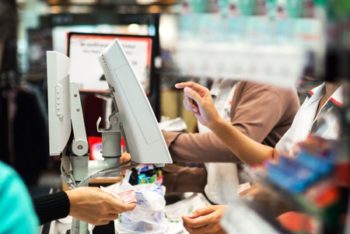Checkout charity – or point-of-sale fundraising – is big business for national nonprofits. But the question here is: Can this type of fundraiser work for smaller, local organizations?
Stores everywhere are getting involved, restaurants too and even local utility companies. After all, what harm is there in asking for a dollar or two to support a worthy cause? A cashier requesting your checkout change while you’re at the cash register is hardly going to break-the-bank.
Point-of-sale fundraising, or “checkout charity,” has become a popular fundraising approach for nonprofits, raising money without a big outlay. The concept also has appeal for retailers, giving them the opportunity to appear altruistic and compassionate with little or no expense.
Checkout charity and consumers
Generally consumers are advised to only donate to recognized organizations with verifiable results. If your nonprofit isn’t big enough to show up on the radar of the big industry players, working locally within the community you serve is one way to reach the donors most impacted by your mission.
The concept of point-of-sale fundraisers has been around for a long time and, despite the love/hate reactions of shoppers, continues to be a major force in cause marketing. Certainly rounding up or donating a couple of dollars at the checkout has become commonplace at grocery stores, drug stores, even restaurants to the dismay of some customers.
The small, local charity that is feeding the hungry, sheltering the homeless or caring for abandoned animals is a force for good, improving life for everyone in the community. If you’re not very big, go local for donations where your brand will be recognized.
Point-of-sale fundraisers are good news
The figures point to one simple fact: checkout charity works and to the tune of some $388 million that was raised at the cash register during 2014. Small change isn’t so small when you put a lot of it together.
One charity benefiting from a point-of-sale campaign was the Streetdog Foundation, who partnered with pet retailer, Hollywood Feed. The regional chain of pet food stores based in Memphis gave shoppers a chance to support Streetdog; a stray and abandoned animal rescue that provides medical and shelter care, and finds forever homes. Hollywood Feed customers contributed $13,000 in the last few months of 2012 and $9,000 more in January 2013, simply by making micro-donations while paying for products and services.
For small organizations, checkout charity should be one of the cornerstones of a cause marketing program for the following reasons.
- The retailer doesn’t usually take a piece of the action or charge the nonprofit a fee.
- Checkout charity is profitable – successful point-of-sale fundraisers have been happening for years.
- Checkout charity is an affordable strategy and one that’s easy to implement.
- Point-of-sale fundraising requires less work (and less people) to implement than other campaigns.
- Checkout charity can be promoted through your social media channels like Twitter, or Facebook because it’s flexible and promotional.
- You can incorporate a charity checkout campaign into another fundraiser such as a walkathon. Enlist point-of-sale partners in place of more customary sponsors.
- For your retail partners, checkout charity can engage customers when co-marketed with coupons or other tactics, attracting new shoppers.
Pairing your point-of-sale campaign with allied businesses could result in even more donations. A food-bank asking for donations at the supermarket or an animal shelter pairing up with the local pet store are natural matches. Checkout fundraisers are successful because that’s where the money is.
Checkout charity has some snags
Despite the success, there are factors inherent in the system that can never replace conventional fundraisers like mail appeals. For one thing, it’s impossible to collect names and addresses to build your database at the checkout. Recognize that checkout charity is just one tool in your arsenal of fundraising strategies and plan accordingly.
Characteristically, there are usually two emotions at play when shoppers are confronted with requests for money at the checkout: benevolence here is often driven by the urge to experience the positive feeling of giving or to avoid looking bad in the eyes of fellow shoppers waiting in line behind you.
Of course, donations at the checkout aren’t obligatory, but some folks who would rather know where their donations are going instead of giving to some faceless national organization. But here is where the smaller homegrown charity, active in the community and known locally for its mission, can benefit.
From supermarkets to restaurants
Checkout charity is bigger than ever as this recent survey revealed. The concept has evolved from supermarkets and drug stores to electricity co-ops and restaurants.
Point-of-sale fundraising and “round-it-up” campaigns are all tailor-made to provide financial assistance to local nonprofit organizations and community projects such as food shelves, community health programs, volunteer fire departments and rural ambulance services.
The sad fact is budget cuts have hit many programs traditionally funded by other means and greatly increased the need for contributions. Smaller agencies and local nonprofits will benefit from the collective small change donated by these initiatives.

